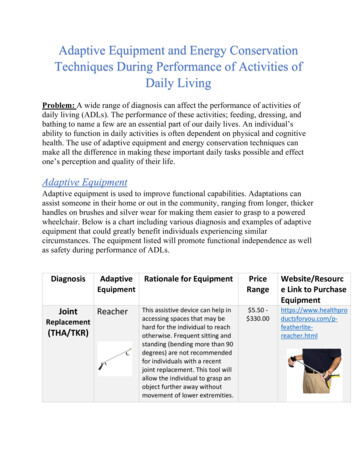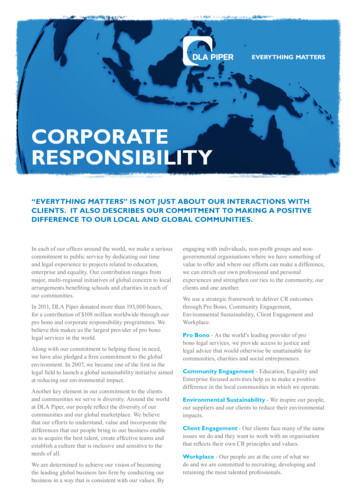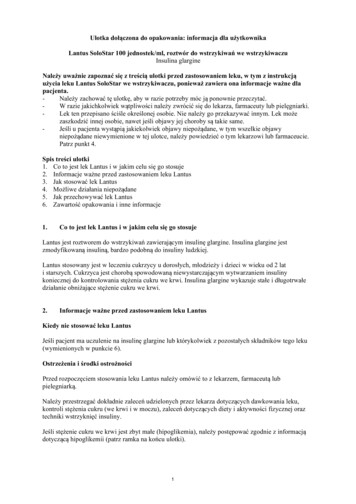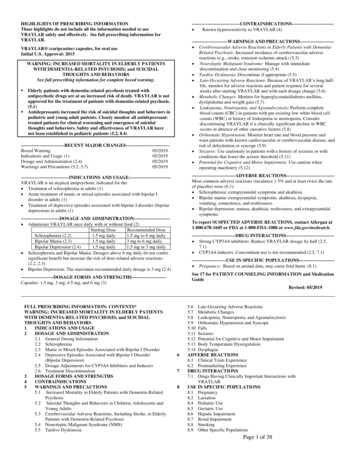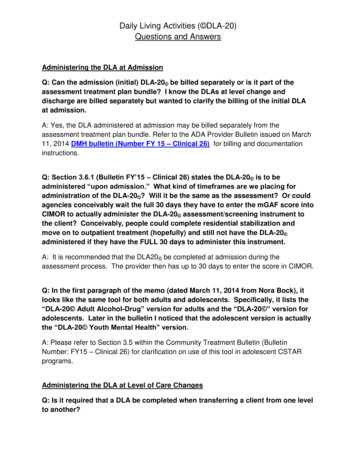
Transcription
Daily Living Activities ( DLA-20)Questions and AnswersAdministering the DLA at AdmissionQ: Can the admission (initial) DLA-20 be billed separately or is it part of theassessment treatment plan bundle? I know the DLAs at level change anddischarge are billed separately but wanted to clarify the billing of the initial DLAat admission.A: Yes, the DLA administered at admission may be billed separately from theassessment treatment plan bundle. Refer to the ADA Provider Bulletin issued on March11, 2014 DMH bulletin (Number FY 15 – Clinical 26) for billing and documentationinstructions.Q: Section 3.6.1 (Bulletin FY’15 – Clinical 26) states the DLA-20 is to beadministered “upon admission.” What kind of timeframes are we placing foradministration of the DLA-20 ? Will it be the same as the assessment? Or couldagencies conceivably wait the full 30 days they have to enter the mGAF score intoCIMOR to actually administer the DLA-20 assessment/screening instrument tothe client? Conceivably, people could complete residential stabilization andmove on to outpatient treatment (hopefully) and still not have the DLA-20 administered if they have the FULL 30 days to administer this instrument.A: It is recommended that the DLA20 be completed at admission during theassessment process. The provider then has up to 30 days to enter the score in CIMOR.Q: In the first paragraph of the memo (dated March 11, 2014 from Nora Bock), itlooks like the same tool for both adults and adolescents. Specifically, it lists the“DLA-20 Adult Alcohol-Drug” version for adults and the “DLA-20 ” version foradolescents. Later in the bulletin I noticed that the adolescent version is actuallythe “DLA-20 Youth Mental Health” version.A: Please refer to Section 3.5 within the Community Treatment Bulletin (BulletinNumber: FY15 – Clinical 26) for clarification on use of this tool in adolescent CSTARprograms.Administering the DLA at Level of Care ChangesQ: Is it required that a DLA be completed when transferring a client from one levelto another?
Daily Living Activities ( DLA-20)Questions and AnswersA: A DLA is required to be completed when transferring a client between levels.Q: When completing a DLA at the time of transfer from one level to another level,which staff completes the DLA?A: The staff from the level the client is leaving should complete the DLA.Q: Within the Bulletin (Number FY 15 – Clinical 26), it lists programs affected as:CSTAR, PR and DOC. Does this include contracted Opioid Treatment Programs(OTPs)? If so, would we require DLA-20 administration upon each of their fivephase changes rather than the three level changes? There may need to be someclarification about this for contracted OTP’s.A: Yes, this requirement applies to Opioid Treatment Programs. The DLA 20 would beadministered in conjunction with the five phase changes.Administering the DLA at DischargeQ: The DLA-20 is supposed to be done at discharge by a Qualified SubstanceAbuse Professional (QSAP). The DLA is also supposed be done based oncontact within the last 30 days with the client. In cases where the QSAP hasn’thad contact in the 30 days prior to discharge, is it acceptable for the CommunitySupport Specialist (CSS) to complete the DLA?A: Yes, if the CSS is the person who knows them the best during the most recent 30day period, then they may complete the DLA at discharge.Q: What do we do about completing the DLA at discharge for clients who take offand do not or are unable to meet with us for aftercare?A: The DLA is a rating for the person over the past 30 days. If you provided servicesduring the 30 days prior to discharge, complete a DLA at discharge. If the person didnot receive services during the most recent 30 day period, then refer to the ModifiedGAF score and criteria (mGAF) and assign a score.Q: What if it is the discharge DLA that is needed and we have not had contactwith the client in the previous 30 days?
Daily Living Activities ( DLA-20)Questions and AnswersA: The DLA is a rating for the person over the past 30 days. If you provided servicesduring the 30 days prior to discharge, complete a DLA at discharge. If the person didnot receive services during the most recent 30 day period, refer to the Modified GAFscore and criteria (mGAF) and assign a score.Q: How do we get discharge DLA-20 scores from clients who drift out ofservices? Are we supposed to do DLA-20 assessments with clients or can it befor the last known contact and how they were doing at that time?A: The DLA is a rating for the person over the past 30 days. If you provided servicesduring the 30 days prior to discharge, complete a DLA at discharge. If the person didnot receive services during the most recent 30 day period, refer to the Modified GAFscore and criteria (mGAF) and assign a score.Q: We were discussing the DLA requirement at discharge. Unfortunately we hada client pass away so the supervisor asked about completing a DLA. Ultimatelythe question is, do we need to complete the DLA on somebody deceased?A: We recommend you complete the discharge DLA when the reason is t the clientpassed away. For data purposes, it will be important to track DLA scores across time,including reasons for discharge. Follow the general guidelines for whether to completea DLA at discharge -- if services were provided within the most recent period of timebefore discharge, a DLA would be completed. If the person did not receive servicesduring the most recent 30 day period, refer to the Modified GAF score and criteria(mGAF) and assign a score.Administering the DLA/CIMORQ: Is the mGAF score entered into CIMOR at each administration of the DLA oronly initial/annual/discharge?A: If the mGAF score changes after administration of the DLA at any point in time, thenew score should be entered in CIMOR as you would with a change in diagnosis on anyother AXIS.Q: The DMH bulletin (Number FY 15 – Clinical 26) Section 3.8 indicates that we
Daily Living Activities ( DLA-20)Questions and Answerssubmit the mGAF score in CIMOR within 30 days of the admission date. Can youtell me if we are to enter all subsequent scores into CIMOR as well?A: Yes, anytime the score changes it should be updated in CIMOR.Staff/TrainingQ: What documentation do I need when I train staff on the DLA? Is there a form,or will a sign-in log work? And since they will ask, does this training provide anyCEUs?A: Documentation to support receipt of the training is required for each staff personadministering the DLA. It is up to each agency to determine how the training will bedocumented. DMH does not have a specific form for documenting this information.CEUs are not provided.Q: In Section 3.2, the Bulletin (Number FY 15 – Clinical 26) requires all agenciesadministering the DLA-20 to receive appropriate training from the developer. Dowe have further information about how agencies might access this training?Website? Specific contact information? Training costs?A: You are correct that all individuals who train other agency staff on use of the DLA20 must be trained by the developer (Willa Premanes) or her approved trainers. TheDepartment of Mental Health and the Missouri Coalition of Community Mental HealthCenters sponsored four regional trainings in January 2014 at no cost to providers. Eachagency was required to send staff to receive the training and, in turn, be the designatedtrainers for their respective agencies. At the present time, there are no additionaltrainings scheduled for 2014. DMH will continue to review the need for additionaltraining, based on feedback from providers, and schedule future training as deemednecessary.Q. Once staff have been trained on the DLA-20 by their agency’s designatedtrainer, can they in turn deliver training to other staff in the agency? Basically,I’m wondering what happens if agencies lose the people who are initially trainedby the developer? Do they have to pay to send other staff to be trained?A: Individuals trained by agency trainers may not be trainers for other agency staff.Designated agency trainers must be trained by the developer (Willa Presmanes)
Daily Living Activities ( DLA-20)Questions and Answersor her designee. The DBH will take under advisement the need for a method toprovide future workshops to train additional DLA 20 agency trainers.Q: Will there be separate adult and adolescent DLA-20 trainings available, or areboth adult and youth assessment tools covered in the single training?A: Training was held in January 2014 and both versions were covered. It is at thediscretion of each agency as to how they will train their staff on the appropriate tool forthe population served.Documentation and BillingQ: We are already using the DLA-20 and wondered if we can start billing it nowinstead of July 1, 2014 (the scheduled implementation date for ADA providers)?A: Yes, once trained, provider staff can begin using the DLA-20 as outlined in the ADAProvider Bulletin issued March 11, 2014 (Number FY 15 – Clinical 26).Q: Section 4.1 (Bulletin FY’15 – Clinical 26) states the initial and discharge DLA20 administrations must be completed by a QSAP. Section 4.2 states that aCommunity Support Specialist may complete the level change administrations ofthe DLA-20 . Section 5.1 states, if the QSAP meets the qualifications of CSS, thencommunity support may be billed. I wasn’t clear whether this QSAP- and CSSqualified individual could bill CSS for just the level change administrations, or if aQSAP- and CSS-qualified individual could also bill initial and dischargeadministrations as a community support service? So, my questions are:a. Can community support be billed for initial and discharge DLA-20s ’ ifthe counselor meets qualifications of both QSAP and CSS, orb. Is it that a QSAP, who also meets CSS criteria, can bill the level changeadministrations as community support?A: A QSAP must complete the DLA20 initially (assessment) and at discharge, and mayalso complete it at level changes. If the QSAP meets the qualifications of a communitysupport specialist, community support may be billed. An agency may choose to havecommunity support specialists administer the DLA 20 at level change instead of theQSAP.
Daily Living Activities ( DLA-20)Questions and AnswersQ: Does the DLA have to be conducted face-to-face with the client, or can it bedone just in consultation between staff? If it is not face-to-face, can the QSAPstill bill individual counseling for it?A: When billing community support, the DLA does not have to be conducted face-toface with the client; however, when billing individual counseling, the DLA must becompleted face-to-face.Q: Section 5.4 (Bulletin FY’15 – Clinical 26), states, “The time spent completingthe DLA-20 must be clearly documented in a progress note ” Is there going tobe any other specifics or requirements for this progress note? Is a placeholderprogress note referencing the actual results/score form acceptable? Or does theprogress note need to recap/summarize the results of the DLA-20 and maketreatment planning recommendations?A: The progress note must indicate the time spent completing the DLA-20 , includingwhether it was administered face-to-face with the client. This is separate and distinctfrom time spent providing services (treatment planning, for example). The note doesnot necessarily need to recap/summarize the results of the DLA 20 .Q: If the mGAF score from the DLA is different from the psychiatrist’s GAF score,which do we use?A: Please consult with the psychiatrist for agreement with the scoring. This new agreedupon mGAF score then becomes the current score. Hopefully the psychiatrist has alsoreceived training on administration of the DLA and will realize that scores may changebased on use of this standardized instrument.Q: Does the DLA have to be completed in the presence of a client to bill for it?A: Individual counseling cannot be billed by the QSAP when the DLA is completedwithout the client being present. Community support should be billed when completingthe DLA without the client being present (the QSAP may only bill CS if s/he meets thequalifications of a community support specialist).
Daily Living Activities ( DLA-20)Questions and AnswersQ: If a client has disengaged from services and we are working onreengagement, my assumption is that we would not do a DLA as we would nothave data from the previous 30 days. Is this accurate?A: Correct, but be sure to document in the record the reason for not completing theDLA.Q: If the modified GAF score has decimal points, do we put in the decimals/roundup/round down?A: Do not use the decimal point; round down. We believe this is in line with WillaPresmanes’ instruction to use the lower score when in doubt. (Ms. Presmanes is thedeveloper and trainer on the DLA-20 .)Q: Are we supposed to begin tracking DLA-20 scores for DMH?A: Yes, but not necessarily for DMH. DLA information helps to target interventions forindividuals based on the areas in which they are assessed to need help. Each time aDLA score is entered into CIMOR, the previous score becomes a “history” score so istracked in CIMOR. Additionally, the score sheet for the DLA shows multiple scores foreach item across time, so changes (or lack of change) for an individual will be evident.It is helpful to compare scores across time so you know if service interventions areeffective or if they need to be revised.Q: How are other agencies managing the ongoing administration of the DLA (inhard copy version)? Do they keep working off of the one DLA score sheet orcontinually fill out a new score sheet at each administration of the DLA?A: We are recommending that, when using a paper form, the same form be usedacross time, filling all the score areas on the right of the form, before moving to anotherform. This assists you in viewing an individual’s change (or lack of) over time.Q: Would we need to put the GAF/mGAF on the DLA or just in the dischargesummary?A: Both. The DLA ends with a GAF/mGAF score. The discharge summary calls fordiagnosis, which includes Axis V.
Daily Living Activities ( DLA-20)Questions and AnswersOtherQ: In the first paragraph of the memo (dated March 11, 2014 from Nora Bock), itstates the DLA-20 will be required for CSTAR and PR ; however, except for theTO: heading at the top of the memo, there is no mention within the memo aboutthe DLA-20 being required for Department of Corrections (DOC) programs.A: Please refer to Section 1.1 within the Community Treatment Bulletin (BulletinNumber: FY15 – Clinical 26) for clarification that the DLA 20 is required for CSTAR,PR and DOC programs.Q: Section 3.5 (Bulletin FY’15 – Clinical 26) addresses the DLA-20 Youth MentalHealth version to be used for adolescents under age 16. It then further elaboratesthat the [adult] Alcohol and Drug version can be used with older adolescents andthat “clinical judgment” will determine which instrument is appropriate for olderadolescents. What factors should be considered when determining whichinstrument to use with older adolescents?A: Providers should use clinical judgment, based on their interaction with the individual,to determine which instrument would be appropriate given the situation, livingenvironment, and abilities of the adolescent.
Questions and Answers Administering the DLA at Admission Q: Can the admission (initial) DLA-20 . discharge are billed separately but wanted to clarify the billing of the initial DLA at admission. A: Yes, the DLA administered at admission may be billed separately from the assessment treatment plan bundle. Refer to the ADA Provider Bulletin .


